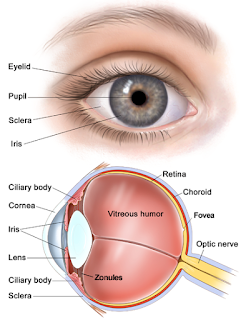The human eye is an organ that reacts to light and has several purposes. As a sense
organ, the mammalian eye allows
for vision.
Today we have learned about the main parts of the human eye.
First, we
have noted those parts in a drawing of a section of the eye. Then we have
defined the specific function of each part. For example, we have learned that
specialized cells located on the retina,
called rods and cones cells, allow for conscious light
perception and vision including color differentiation and the perception of
depth.
The human eye can
distinguish about ¡¡¡10 million colors!!!
The eye is not shaped
like a perfect sphere. The smaller frontal unit, transparent and more curved,
called the cornea is linked to the
larger white unit called the sclera.
The iris is the colored circular structure
concentrically surrounding the center of the eye, the pupil, which appears to be black. The size of the pupil, which
controls the amount of light entering the eye, is adjusted by the muscles of the iris.
With all this information, we have made
a mural.
In the next practice at the lab, we will use that information to dissect
a sheep's eye and try to understand how this important sensory organ works. We expect new emotions!
Did you know that a device known as an ophthalmoscope is used to see inside the eye?











